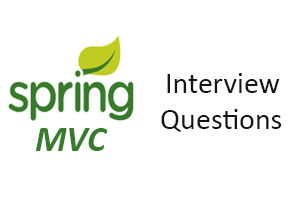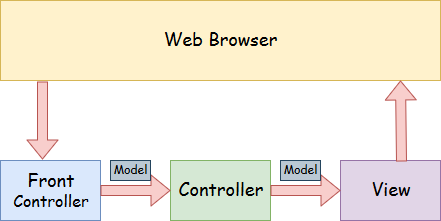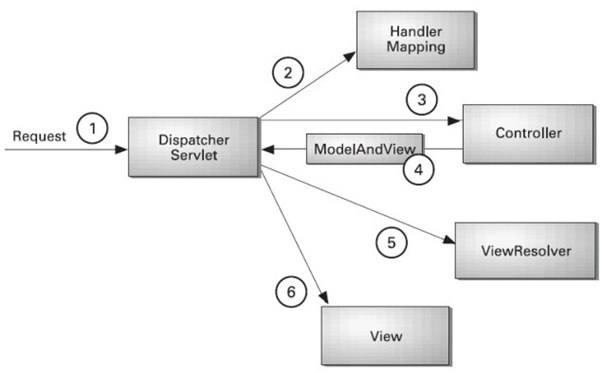Spring MVC Interview Questions
A list of top frequently asked Spring MVC Interview Questions and answers are given below. 1) What is MVC?The MVC (Model-View-Controller) is a software architectural design pattern. It separates the functionality of an application into three interconnected parts - Model, View, and Controller. This approach facilitates the reusability of the code and parallel development. 2) What is Spring MVC?A Spring MVC is a Java Framework which is used to develop dynamic web applications. It implements all the basic features of a core spring framework like Inversion of Control and Dependency Injection. It follows the Model-View-Controller design pattern. 
Here,
3) What is the front controller of Spring MVC?The front controller is a DispatcherServlet class present in org.springframework.web.servlet package. It dispatches the request to the appropriate controller and manages the flow of the application. It is required to specify the DispatcherServlet class in the web.xml file. 4) Explain the flow of Spring MVC?
5) What are the advantages of Spring MVC Framework?The following are the advantages of Spring MVC Framework : -
6) What does an additional configuration file contain in Spring MVC application?The Spring MVC application contains an additional configuration file that contains the properties information. This file can be created either in the form of an xml file or properties file. In this file, we generally define the base-package and view resolver where DispatcherServlet searches for the controller classes and view components path. However, it can also contain various other configuration properties. 7) What is an InternalResourceViewResolver in Spring MVC?The InternalResourceViewResolver is a class which is used to resolve internal view in Spring MVC. Here, you can define the properties like prefix and suffix where prefix contains the location of view page and suffix contains the extension of view page. For example:- 8) How to declare a class as a controller class in Spring MVC?The @Controller annotation is used to declare a class as a controller class. It is required to specify this annotation on the class name. For example:- 9) How to map controller class and its methods with URL?The @RequestMapping annotation is used to map the controller class and its methods. You can specify this annotation on the class name as well as method name with a particular URL that represents the path of the requested page. For example:- 10) Name the annotations used to handle different types of incoming HTTP request methods?The following annotations are used to handle different types of incoming HTTP request methods: -
11) What is the purpose of @PathVariable annotation in Spring MVC?The @PathVariable annotation is used to extract the value of the URI template. It is passed within the parameters of the handler method. For example :- 12) What is the role of @ResponseBody annotation in Spring MVC?The @ResponseBody annotation is used to serialize the returned object automatically in JSON and bind it with the Http response body. Here, it not required to invoke the model. For example :- 13) What is the role of the Model interface in Spring MVC?The Model interface works as a container that contains the data of the application. Here, data can be in any form such as objects, strings, information from the database, etc. 14) What do you mean by ModelAndView in Spring MVC?The ModelAndView is a class that holds both Model and View where the model represents the data, and view represents the representation of that data. This class returns the model and view in the single return value. 15) What is ModelMap in Spring MVC?The ModelMap is a class that provides the implementation of Map. It extends the LinkedHashMap class. It facilitates to pass a collection of values as if they were within a Map. 16) What are the ways of reading data from the form in Spring MVC?The following ways to read the data from the form are: -
17) What is Spring MVC form tag library?The Spring MVC form tags can be seen as data binding-aware tags that can automatically set data to Java object/bean and also retrieve from it. These tags are the configurable and reusable building blocks for a web page. It provides view technologies, an easy way to develop, read, and maintain the data. 18) What do you understand by validations in Spring MVC?The validation is one of the most important features of Spring MVC, that is used to restrict the input provided by the user. To validate the user's input, it is required to use the Spring 4 or higher version and Bean Validation API. Spring validations can validate both server-side as well as client-side applications. 19) What is Bean Validation API?The Bean Validation API is a Java specification which is used to apply constraints on object model via annotations. Here, we can validate a length, number, regular expression, etc. Apart from that, we can also provide custom validations. As Bean Validation API is just a specification, it requires an implementation. So, for that, it uses Hibernate Validator. The Hibernate Validator is a fully compliant JSR-303/309 implementation that allows to express and validate application constraints. 20) What is the use of @Valid annotation in Spring MVC?The @Valid annotation is used to apply validation rules on the provided object. 21) What is the purpose of BindingResult in Spring MVC validations?The BindingResult is an interface that contains the information of validations. For example :- 22) How to validate user's input within a number range in Spring MVC?In Spring MVC Validation, we can validate the user's input within a number range by using the following annotations: -
23) How to validate the user input in a particular sequence in Spring MVC?The Spring MVC Validation allows us to validate the user input in a particular sequence by using @Pattern annotation. Here, we can provide the required regular expression to regexp attribute and pass it with the annotation. 24) What is the purpose of custom validations in Spring MVC?The Spring MVC framework allows us to perform custom validations. In such a case, we declare our own annotations. We can perform validation based on own business logic. 25) What do you understand by Spring MVC Tiles?The Spring provides integration support with apache tiles framework. So we can manage the layout of the Spring MVC application with the help of spring tiles support. The following are the advantages of Tiles support in Spring MVC: -
|
You may also like:
- Java Interview Questions
- SQL Interview Questions
- Python Interview Questions
- JavaScript Interview Questions
- Angular Interview Questions
- Selenium Interview Questions
- Spring Boot Interview Questions
- HR Interview Questions
- C Programming Interview Questions
- C++ Interview Questions
- Data Structure Interview Questions
- DBMS Interview Questions
- HTML Interview Questions
- IAS Interview Questions
- Manual Testing Interview Questions
- OOPs Interview Questions
- .Net Interview Questions
- C# Interview Questions
- ReactJS Interview Questions
- Networking Interview Questions
- PHP Interview Questions
- CSS Interview Questions
- Node.js Interview Questions
- Spring Interview Questions
- Hibernate Interview Questions
- AWS Interview Questions
- Accounting Interview Questions







